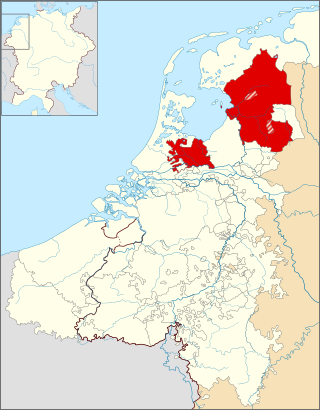
Year 1227 (MCCXXVII) was a common year starting on Friday of the Julian calendar.

Drenthe is a province of the Netherlands located in the northeastern part of the country. It is bordered by Overijssel to the south, Friesland to the west, Groningen to the north, and the German state of Lower Saxony to the east. As of January 2023, Drenthe had a population of about 502,000, and a total area of 2,680 km2 (1,030 sq mi).

The Bishopric of Utrecht was an ecclesiastical principality of the Holy Roman Empire in the Low Countries, in the present-day Netherlands. From 1024 to 1528, as one of the prince-bishoprics of the Holy Roman Empire, it was ruled by the bishops of Utrecht.

Otto of Lippe was a son of Bernhard II, Lord of Lippe. He was bishop of Utrecht as Otto II from 1216 to 1227. Several of his brothers also held high ecclesiastical offices in the Rhineland. He likely participated in the foundation of the Teutonic Order.

Gramsbergen is a small Dutch city on the Vechte, located in the municipality of Hardenberg and the province of Overijssel. The town is located on corridors of different transportation modes: The N34, the Zwolle - Emmen railway and the Almelo - de Haandrik canal.
Floris IV was the count of Holland from 1222 to 1234. He was born in The Hague, a son of William I of Holland and his first wife, Adelaide of Guelders.

Jipsinghuizen is a hamlet in the Dutch province of Groningen. It is a part of the municipality of Westerwolde, and lies about 28 km northeast of Emmen. The statistical area "Jipsinghuizen", which also can include the surrounding countryside, has a population of around 150. Jipsinghuizen used to be part of the municipality of Vlagtwedde, but merged into Westerwolde in 2017. In 1665, the Battle of Jipsinghuizen was fought between Münster and the Dutch Republic.
The Drenther Crusade was a military campaign launched against the inhabitants of Drenthe with the approval of the Papacy in 1228 and lasting until 1232. It was led by Willibrand, Bishop of Utrecht, commanding an army composed mostly of Frisian crusaders.

Gerard III of Guelders was the Count of Guelders and Zutphen from 1207 until his death in 1229. He was a son of Count Otto I of Guelders, and is sometimes called Gerard IV or Gerard V. Gerard married Margaretha of Brabant, the daughter of Duke Hendrik I of Brabant and Matilda of Flanders, Duchess of Brabant, in 1206.

Ane is a village in the Dutch province of Overijssel. It is located in the municipality Hardenberg, about 5 km northeast of the centre of Hardenberg.

Bernard II was Lord of Lippe from 1167 until 1196. He founded the towns of Lippstadt and Lemgo.
Herman II, Lord of Lippe was a ruling Lord of Lippe.
Baldwin van Holland was a bishop of Utrecht from 1178 to 1196

Wilbrand of Oldenburg was a bishop of Paderborn and of Utrecht.
The historic Diocese of Utrecht was a diocese of the Latin Church of the Catholic Church from 695 to 1580, and from 1559 archdiocese in the Low Countries before and during the Protestant Reformation.

Rudolph van Coevorden was a feudal lord of the Drenthe who led a rebellion against Otto II, Bishop of Utrecht. He defeated and killed Otto at the Battle of Ane in 1228. Otto's successor, Wilbrand, initiated a crusade against the Drenthers. During a truce in 1230, Rudolph was arrested at a meeting in Hardenberg and executed.

The siege of Coevorden was a thirty-one-week siege of the city of Coevorden in the province of Drenthe by the Spanish general Francisco Verdugo during the Eighty Years' War and the Anglo–Spanish War. The siege first commenced in October 1593, but winter and shortages of food and supplies forced the Spanish into winter quarters. The siege however recommenced in March 1594, but on May 6 Maurice of Orange arrived with an Anglo-Dutch army to relieve Coevorden, forcing the Spanish army under Francisco Verdugo to retreat.
Quaedam narracio de Groninghe, de Thrente, de Covordia et de diversis aliis sub diversis episcopis Traiectensibus, usually just Quaedam narracio for short, is an anonymous Latin prose chronicle written in 1232–33 by a Frisian clergyman attached to Bishop Willibrand of Utrecht. It was written during the Drenther uprising of 1227–1232.











